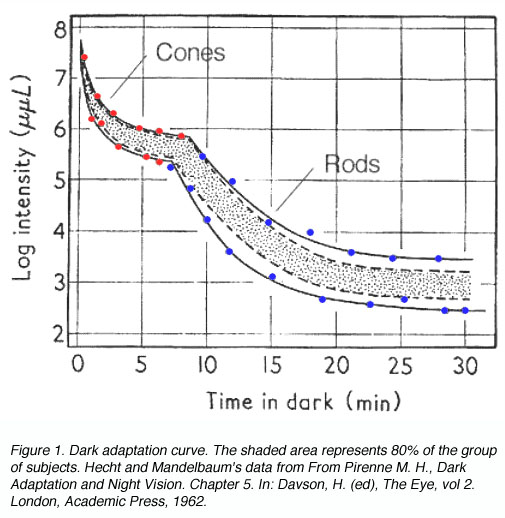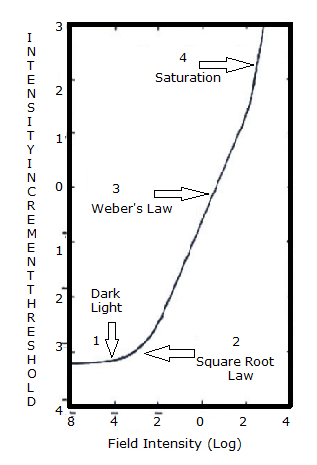Vision adaptation
The sensitivity of our eye can be measured by determining the absolute intensity threshold, that is, the minimum luminance of a test spot required to produce a visual sensation. This can be measured by placing a subject in a dark room, and increasing the luminance of the test spot until the subject reports its presence. Hermann Rudolph Aubert (1865) was the first to estimate the threshold stimulus of the eye in the dark by measuring the electrical current required to render the glow on a platinum wire just visible. He found that the sensitivity had increased 35 times after time in the dark, and also introduce for the term “adaptation”. According to a widely held theory of vision, the rods are responsible for vision under very dim levels of illumination (scotopic vision) and the cones function at higher illumination levels (photopic vision). Photopic vision provides the capability for seeing color and resolving fine detail (20/20 of better), but it functions only in good illumination. Scotopic vision is of poorer quality; it is limited by reduced resolution ( 20/200 or less) and provides the ability to discriminate only between shades of black and white
This dual-receptor system allows the human eye to maintain sensitivity over an impressively large range of ambient light levels. Between the limits of maximal photopic vision and minimal scotopic vision, the eye can function rather effectively to changes in brightness of as much as 1,000,000,000 times. The sensitivity of the eye automatically adjusts to changes in illumination. The dimmest light in which the rods can function is equivalent to ambient conditions of an overcast night with no moonlight. The dimmest light in which the cones can function is roughly equivalent to a night with 50% moonlight. Thus a white which can just barely be seen by the rods must be increased in brightness 1,000 times before it becomes visible to the cones. The light intensity of the sun is approximately 30,000 times that of the moon, yet the eye can function well in bright sunlight as well as in dim moonlight. Dark adaptation forms the basis of the Duplicity Theory which states that above a certain luminance level (about 0.03 cd/m2), the cone mechanism is involved in mediating vision; photopic vision. Below this level, the rod mechanism comes into play providing scotopic (night) vision. The range where two mechanisms are working together is called the mesopic range.
The dark adaptation curve, shown below, depicts this duplex nature of our visual system (figure 1). The first curve reflects the cone mechanism. The sensitivity of the rod pathway improves considerably after 5-10 minutes in the dark and is reflected by the second part of the dark adaptation curve.

There are three main factors affect dark adaption:
- Intensity and Duration of the pre-adapting light: by increasing the levels of pre-adapting luminances, the duration of cone mechanism dominance extends, while the rod mechanism switch over is more delayed. In addition the absolute threshold takes longer to reach. The opposite is true for decreasing the levels of pre-adapting luminances.
- Size and Location on the Retina: the location of the test spot affects the dark adaptation curve because of the distribution of the rods and cones in the retina.
- Rhodopsin Regeneration: dark adaptation depends upon photopigment bleaching, which effects the threshold of both cones and rods.
Light adaptation is the adjustment of retinal response properties to variations in ambient illumination. It enables the encoding of visual information over a millionfold intensity range, from moonlight to broad daylight, despite the relatively small dynamic range of response of visual neurones.
The process of adapting to the light and can be explained by a reduction in gain of the photometry, linked mainly to the variations in the concentration of Ca2 in the photoreceptors in following the closure of membrane channels sensitive to GMPC brought caused by light; the process of adapting to the darkness and explained by an increase in the gain of the photometry and with the progressive new synthesis of fotopigmento, a phenomenon that requires long periods of time (of the order of 6 minutes in cones and 25/30 minutes in the rods), which provides a reason of the longer duration of the process of adaptation to the dark than in light.
Part of the adaptation within the photoreceptors is due to photopigment bleaching - less photopigment available at high light levels results in weaker responses to light increments at those high light levels. Adaptation within the photoreceptors is also helped along by feedback from horizontal cells onto the photoreceptors to control the responsiveness of the photoreceptors. If the horizontal cells respond strongly then they tell the photoreceptors to turn it down a bit.
Photochemical Process:
chemwiki.ucdavis.edu/@api/deki/files/735/531vision.gif?size=bestfit&width=346&height=364&revision=1
With light adaptation, the eye has to quickly adapt to the background illumination to be able to distinguish objects in this background. The process for light adaptation occurs over a period of five minutes.
Using increment threshold experiments, light adaptation can be measured clinically. In an increment threshold experiment, a test stimulus is presented on a background of a certain luminance, the stimulus is increased until the detection threshold is reached against the background. A monophasic or biphasic threshold versus intensity TVI curve is obtained through this method for both cones and rods.
When the threshold curve for a single system, i.e. just cones or just rods, is taken in isolation it can been seen to possesses four sections:
- Dark light: threshold in this portion of the TVI curve is determined by the dark/light level. Sensitivity is limited by neural noise. The background field is relatively low and does not significantly affect threshold.
- Square root law: this part of the curve is limited by quantal fluctuation in the background. The visual system is usually compared with a theoretical construct called the ideal light detector. To detect the stimulus, the stimulus must sufficiently exceed the fluctuations of the background (noise).
- Weber's law: threshold increases with background luminance proportional to the square root of the background.
- Saturation: at saturation, the rod system becomes unable to detect the stimulus. This section of the curve occurs for the cone mechanism under high background levels.

References:
- www.webvision.med.utah.edu/book/part-viii-gabac-receptors/light-and-dark-adaptation
- www.en.wikipedia.org/wiki/Adaptation_%28eye%29
- www.treccani.it
- www.ncbi.nlm.nih.gov/pubmed/6462216



